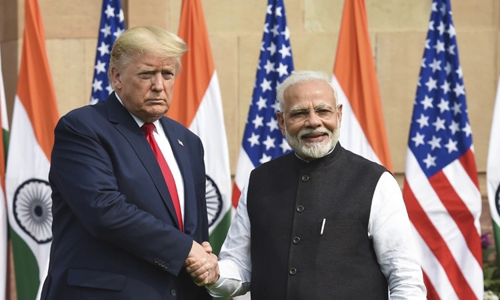Trump has not yet signed a trade deal with India at the end of a visit full of public images but is said to be "lacking in quality".
US President Trump arrived in India on February 24, starting the first official visit to the country since taking office. The White House boss spoke at the world's largest cricket stadium in Gujarat state, the home of Prime Minister Narendra Modi, before 100,000 people had been waiting for him since 4am.

US President Donald Trump (left) and Indian Prime Minister Narendra Modi at Hyderabad House, New Delhi, February 25 Photo: AFP.
New Delhi was well-prepared for this important event, as workers rushed to complete the stadium and erected a wall to obscure the surrounding slums. Wild dogs, cows and monkeys were relocated.
India also erected thousands of banners on the road, while Trump and Modi flags were sold well. Tens of thousands of people showed up along the way to the stadium, while Trump earlier said that "6-10 million people" would welcome him.
The US president praised Modi as "a true friend", praised the US-India relationship and expressed his desire to strengthen ties between the two countries. Leaders of the two countries also shared concerns about China and wanted to strengthen defense relations. The US president announced the signing of a deal to buy helicopter and advanced equipment worth US $ 3 billion for the Indian armed forces on February 25.
The White House boss also expressed an interest in expanding space cooperation with New Delhi, saying the two sides are moving towards a "staggering" trade deal. However, there are still many disagreements in the economic field between the two countries when Trump's "America first" policy collided with Modi's policy of strengthening domestic capacity "Make in India".
When he delivered a speech to end the short trip to the Taj Mahal with First Lady Melania, Trump pointed out that the United States and India have made "great progress" for an "amazing" trade deal. . The White House boss later added, "The United States must be treated fairly and India understands that if the two countries have a trade agreement by the end of the year."
India last year was one of the countries Trump imposed import duties on steel and aluminum, 25% and 10% respectively. The US president also removed many Indian goods from the universal tariff preferential program (GSP). This is considered an attempt by the White House boss to reduce the US $ 25 billion trade deficit with Asia's third largest economy.
Modi, who is trying to boost the economy with growing inflation and budget deficits, has also responded to higher tariffs on U.S. goods, including value-added California almonds. 600 million USD.
The US president had good memories during his first trip to India, but the prospect of a trade agreement between the largest economy and the second most populous country in the world is still considered "far away". . Many speculate that the deal could happen when India lowers tariffs on Harley-Davidson motorcycles and other US goods.
"Harley-Davidson has to pay very high taxes when they bring motorbikes here, while India also sells motorcycles to the US and almost no tax. That's not fair. I want to go back and forth. It must be, "Trump said at a press conference.
In addition to trade, US-Indian relations are said to be very different. New Delhi has repeatedly rejected the White House boss's proposal to mediate conflict in Kashmir. Meanwhile, Washington was unhappy when the Indian parliament passed a bill to grant citizenship to immigrants from Afghanistan, Bangladesh and Pakistan but excluding Muslims in late 2019.



 TokyNoelMarcelin
TokyNoelMarcelin







